Clocks
An overview
Since the beginning of civilization, humans have searched for a reliable way to keep track of the time. In the earliest days, months, seasons and years were tracked by careful monitoring of the phases of the moon. Later, the sun and stars were also used to help early people track the passing of time.
The Sumerians used the sundial to divide days into two-hour segments. The Egyptians created a device called Cleopatra's needle to divide their days into two-hour segments while the ancient Romans devised a way of dividing time into night and day.
A pressing need for more precise measurements led to the invention of the water clock and then the hourglass. These inventions were limited as they relied on water and sand, respectively, to function. The search continued to search for a way of tracking time independent of the seasons or nature.
Carriage Clocks
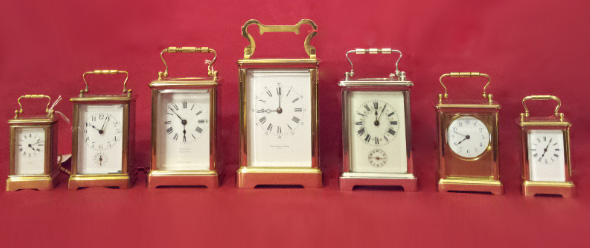
|
A carriage clock is a small, spring-driven clock, designed for travelling, developed in the early 19th century in France, where they were also known as "Officers' Clocks”.

|
Longcase Clocks
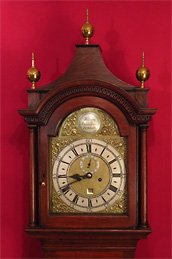
|
The Longcase clock made from the 17th century to the 19th century, was the first really accurate domestic clock. Although the Dutch pioneered the making of Longcase Clocks, the English took over the lead. Grandfather clocks stand about 6.5 to 8 feet tall. Grandmother clocks 6feet and grand daughter clocks 5feet.
Each of them is an excellent choice for starting a family heirloom.

|
Mantle Clocks
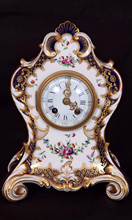
|
Mantel clocks — or shelf clocks — are relatively small house clocks traditionally placed on the shelf, or mantel, above the fireplace. The form, first developed in France in the 1750s, can be distinguished from earlier chamber clocks of similar size due to a lack of carrying handles.

|
Bracket Clocks
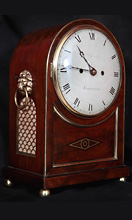
|
Bracket clocks were among the most popular of early clocks and were often considered to be status symbols for their owners. They were usually high quality fusee driven movements that had highly engraved rear plates which could be seen through the glass rear door.
17th ,18th and early 19th century fusee bracket clocks are highly sought after, when they were introduced they were a real technological achievement and they actually were more expensive than the equivalent grandfather, only the top 5% of gentry could afford such clocks.

|
Wall Clocks
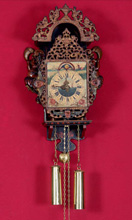
|
Everyone owns at least one clock and generally that is a clock that hangs on the wall. These types of clock have been around the longest. Even grandfather clocks started on the wall, and as their pendulums became longer and longer they were put into long cases and moved to the floor.

|
Marine Chronometers
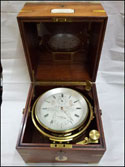
|
A marine chronometer is a clock that is precise and accurate enough to be used as a portable time standard; it can therefore be used to determine longitude by means of celestial navigation. When first developed in the 18th century, it was a major technical achievement, as accurate knowledge of the time over a long sea voyage is necessary for navigation, lacking electronic or communications aids. The first true chronometer was the life work of one man, John Harrison, spanning 31 years of persistent experimentation and testing that revolutionized naval (and later aerial) navigation and enabling the Age of Discovery and Colonialism to accelerate.

|
Master Clocks
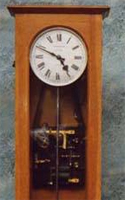
|
A master clock is a precision clock that provides timing signals to synchronise slave clocks as part of a clock network. Networks of electric clocks connected by wires to a precision master pendulum clock began to be used in institutions like factories, offices, railway networks, telephone exchanges and schools around 1900.
The clock timing signals, generated by electrical contacts attached to the mechanism, were minute, half minute and sometimes one second electrical pulses, fed to the controlled equipment on pairs of wires. The devices driven could be wall clocks, tower clocks, factory sirens, school bells and occasionally clock chiming mechanisms. "

|
Boulle Clocks

|
André-Charles Boulle (11 November 1642 – 29 February 1732), le joailler du meuble (the "furniture jeweller"), is the most famous French cabinetmaker and the preeminent artist in the field of marquetry, also known as "Inlay". Boulle was "the most remarkable of all French cabinetmakers". He was recommended to Louis XIV of France, the "Sun King", by Jean-Baptiste Colbert (29 August 1619 – 6 September 1683) as being “the most skilled craftsman in his profession”. Over the centuries since his death, his name and that of his family has been given to the art he perfected, the inlay of tortoiseshell, brass and pewter into ebony. It is known as Boulle Work and the École Boulle, a college of fine arts and crafts and applied arts in Paris, today bears testimony to his enduring art, the Art of inlay. From Wikipedia.

|
|










